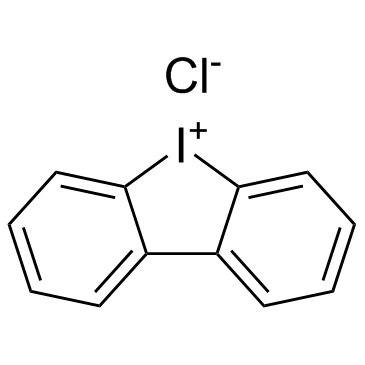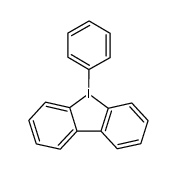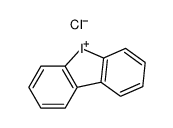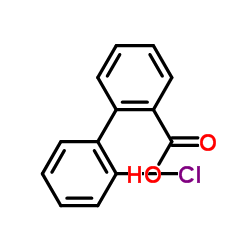Diphenyleneiodonium chloride

Diphenyleneiodonium chloride structure
|
Common Name | Diphenyleneiodonium chloride | ||
|---|---|---|---|---|
| CAS Number | 4673-26-1 | Molecular Weight | 314.54900 | |
| Density | N/A | Boiling Point | N/A | |
| Molecular Formula | C12H8ClI | Melting Point | 312-322ºC | |
| MSDS | Chinese USA | Flash Point | N/A | |
Use of Diphenyleneiodonium chlorideDiphenyleneiodonium chloride is a NADPH oxidase (NOX) inhibitor and also functions as a TRPA1 activator with an EC50 of 1 to 3 μM. |
| Name | dibenziodolium chloride |
|---|---|
| Synonym | More Synonyms |
| Description | Diphenyleneiodonium chloride is a NADPH oxidase (NOX) inhibitor and also functions as a TRPA1 activator with an EC50 of 1 to 3 μM. |
|---|---|
| Related Catalog | |
| Target |
NOX[1] EC50: 1 to 3 μM (TRPA1)[1] |
| In Vitro | Diphenyleneiodonium chloride is a NADPH oxidase (NOX) inhibitor and also functions as a TRPA1 activator with an EC50 of 1 to 3 μM. Application of Diphenyleneiodonium chloride to HEK-TRPA1 cells at a concentration ranges of 0.03 to 10 μM effectively induces a Ca2+ response. However, Diphenyleneiodonium chloride fails to evoke a Ca2+ response in control HEK cells, even at a relatively high dose of 10 μM[1]. When Diphenyleneiodonium chloride is included in the co-cultures, lipopolysaccharide (LPS)-induced preOL apoptosis is significantly inhibited. Treatment with Diphenyleneiodonium chloride is found to significantly attenuate the LPS-induced O2- production by 2.0-fold, reducing it to within 27% of the controls[2]. |
| In Vivo | Intraplantar injection of 2 mM Diphenyleneiodonium chloride to the hindpaw causes licking or biting behavior[1]. Diphenyleneiodonium chloride treatment immediately or 24 h after lipopolysaccharide (LPS) injection significantly attenuates the LPS-induced loss of O4 positive cells. Treatment with Diphenyleneiodonium chloride either immediately or 24 h after LPS injection significantly ameliorates the LPS-induced disorganization of the white matter nerve fibers. However, treatment with DPI 48 h after LPS injection does not appear to correct the LPS-induced white matter damage. DPI treatment either immediately or 24 h after LPS injection significantly reduces the accumulation of both gp91phox and p67phox in the membrane fraction[2]. |
| Cell Assay | Purified microglia and preOLs are co-cultured using a Transwell culture system. Co-cultured cells are divided into three groups: control, lipopolysaccharide (LPS)-activated, and LPS plus Diphenyleneiodonium chloride. Microglia are cultured in Transwells over established preOL layers and exposed to either LPS (100 ng/mL), LPS+Diphenyleneiodonium chloride (10 μM) or untreated. The medium supernatants and cellular protein fractions from the co-cultures are then collected for further analysis after 48 h incubation[2]. |
| Animal Admin | The ddy mice (6 to 7 wk of age) are individually placed in transparent cages for 30 min before experiments. An intraplantar injection of 10 μL Diphenyleneiodonium chloride (2 mM, solvent: Kolliphor EL with 20% DMSO) is then injected into the right hindpaw with or without intraperitoneal administration with HC030031 (300 mg/kg at 0.5 h prior to injection of Diphenyleneiodonium chloride; solvent: saline with 0.5% methyl cellulose). The time spent licking or biting the injected paw is recorded for 45 min after injection[1]. |
| References |
| Melting Point | 312-322ºC |
|---|---|
| Molecular Formula | C12H8ClI |
| Molecular Weight | 314.54900 |
| Exact Mass | 313.93600 |
| Appearance of Characters | Powder | Off-white |
| InChIKey | FCFZKAVCDNTYID-UHFFFAOYSA-M |
| SMILES | [Cl-].c1ccc2c(c1)[I+]c1ccccc1-2 |
| Storage condition | -20°C |
|
~% 
Diphenyleneiodo... CAS#:4673-26-1 |
| Literature: Journal of the American Chemical Society, , vol. 74, p. 274 |
|
~% 
Diphenyleneiodo... CAS#:4673-26-1 |
| Literature: Journal of Organic Chemistry, , vol. 34, # 2 p. 456 - 457 |
|
~% 
Diphenyleneiodo... CAS#:4673-26-1 |
| Literature: Chemische Berichte, , vol. 88, p. 268 |
|
~% 
Diphenyleneiodo... CAS#:4673-26-1 |
| Literature: Chemische Berichte, , vol. 88, p. 268 |
| HS Code | 2903999090 |
|---|---|
| Summary | 2903999090 halogenated derivatives of aromatic hydrocarbons VAT:17.0% Tax rebate rate:9.0% Supervision conditions:none MFN tariff:5.5% General tariff:30.0% |
|
Superparamagnetic iron oxide nanoparticles exacerbate the risks of reactive oxygen species-mediated external stresses.
Arch. Toxicol. 89(3) , 357-69, (2015) Superparamagnetic iron oxide nanoparticles (IONPs) have been widely applied in numerous biomedical fields. The evaluation of the toxicity of IONPs to the environment and human beings is indispensable ... |
|
|
Neurological sequelae induced by alphavirus infection of the CNS are attenuated by treatment with the glutamine antagonist 6-diazo-5-oxo-l-norleucine.
J. Neurovirol. 21(2) , 159-73, (2015) Recovery from encephalomyelitis induced by infection with mosquito-borne alphaviruses is associated with a high risk of lifelong debilitating neurological deficits. Infection of mice with the prototyp... |
|
|
EW-7197 inhibits hepatic, renal, and pulmonary fibrosis by blocking TGF-β/Smad and ROS signaling.
Cell. Mol. Life Sci. 72(10) , 2023-39, (2015) Fibrosis is an inherent response to chronic damage upon immense apoptosis or necrosis. Transforming growth factor-beta1 (TGF-β1) signaling plays a key role in the fibrotic response to chronic liver in... |
| Diphenyleneiodonium chloride |
| DPI Dibenziodolium chloride |
| MFCD00214165 |




 CAS#:14498-95-4
CAS#:14498-95-4
